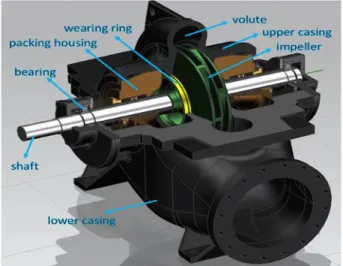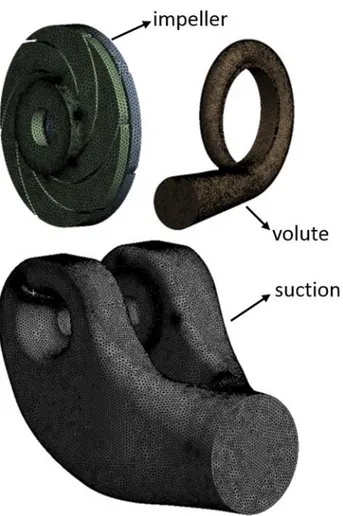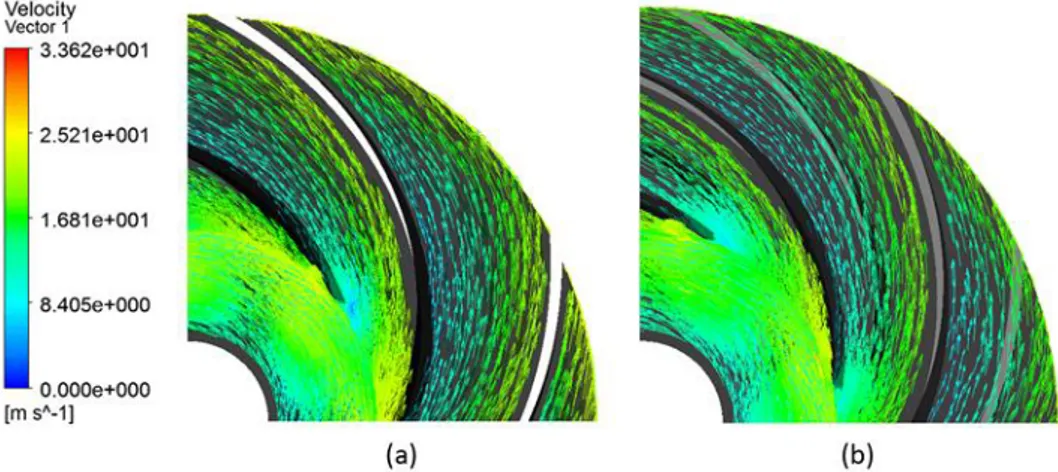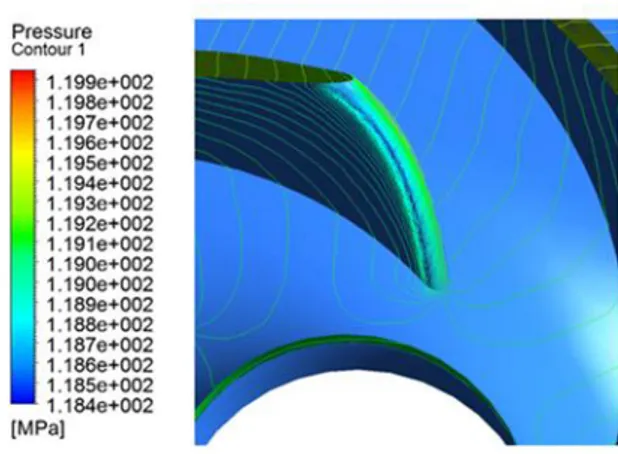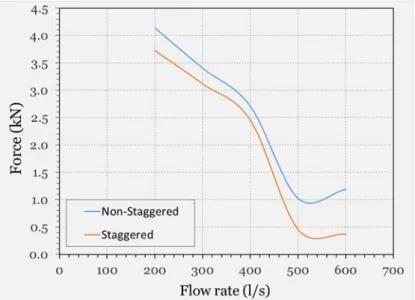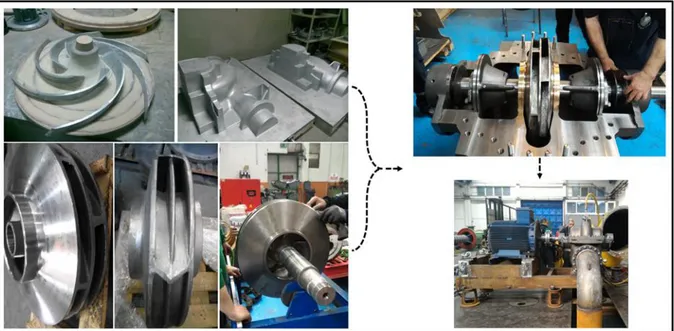Adıyaman Üniversitesi
Mühendislik Bilimleri Dergisi
8 (2018) 135-146
AYRILABİLİR GÖVDELİ, ŞAŞIRTMALI KANAT DİZİLİMİNE SAHİP
ÇİFT EMİŞLİ POMPA TASARIMI VE İMALİ
Hıdır Yankı KILIÇGEDİK
1*, Mustafa Turhan ÇOBAN
1, Ahmet Özden ERTÖZ
2 1Department of Mechanical Engineering, Ege University, Izmir, Turkey2Vansan Water Technologies, Izmir, Turkey Geliş tarihi: 02.01.2018 Kabul tarihi: 14.05.2018
ÖZET
Bir santrifüj pompanın çalışma ömrü, radyal kuvvetlerin büyüklüğüne bağlıdır. Bu kuvvetler, çark ve salyangozun karmaşık etkileşiminin bir sonucu olan basınç dalgalanmalarına bağlıdır. Çift salyangozlu yapılar, radyal kuvvetlerin azaltılması amacıyla yıllarca başarıyla kullanılmıştır. Ancak, bu yöntem ciddi üretim problemlerini ve verim kayıplarını da beraberinde getirmektedir. Bu çalışmada çift emişli bir pompada radyal kuvvetlerin azaltılması için şaşırtmalı kanat dizilimi adı verilen yeni bir yaklaşımın etkinliğinin kullanılması amaçlanmaktadır. Bu amaçla basınç, hız ve reaksiyon kuvvetleri gibi birkaç temel parametrenin karşılaştırmalı analizleri gerçekleştirilmiştir. Geliştirilen Hesaplamalı Akışkanlar Dinamiği modelinin doğruluğu pompa performans testleriyle de doğrulanmıştır. Çalışma neticesinde, şaşırtmalı kanat tasarımının, çift salyangozlu yapıya gerek duymadan bir santrifüj pompada radyal kuvvetleri azaltmak için etkili bir yöntem olarak kullanılabileceği ortaya konulmuştur.
Anahtar Kelimeler: Santrifüj pompa; şaşırtmalı kanat; hesaplamalı akışkanlar dinamiği; radial kuvvet; basınç dalgası.
A STUDY ON THE UNSTEADY PRESSURE CHARACTERISTICS IN A
DOUBLE SUCTION CENTRIFUGAL PUMP WITH STAGGERED
BLADE ARRANGEMENT
ABSTRACT
The operating life of a centrifugal pump is effected by the magnitude of the radial forces. Fundamentally, these forces are due to pressure variations around the impeller periphery which is a result of the complex interaction of two main components; impeller and volute. There are several approaches in the literature for load reduction. Double volute pumps have been successfully used for years. However, this method involves serious manufacturing problems and efficiency losses. This paper aims at using the effectiveness of a new approach called staggered blade arrangement for the reduction of radial forces in a double suction pump. A comparative analysis is performed by judging several key parameters such as pressure, velocity and reaction forces. The accuracy of the developed Computational Fluid Dynamics model was also verified with the pump performance tests. The outcomes of the study revealed that staggered blade arrangement can be used as an effective tool for reducing the radial forces in a centrifugal pump without needing to double volute design.
Keywords: Centrifugal pump, staggered blade, computational fluid dynamics, radial force, pressure pulsation.
1. Introduction
Pressure pulsations are unsteady fluctuations caused by impeller-volute interaction. They are usually induced by the swirling flow inside the centrifugal pump and they can have a significant effect on stable operation of a pump [1]. Even when the geometry of the impeller matches well with the geometry of the volute, pressure pulsations may still be present [2]. Since all centrifugal pumps operate with pulsations, it is necessary to reduce them to a minimum level with an optimum design. Many studies have been performed on pressure pulsation characteristics of centrifugal pumps and most of them emphasized the effects of geometrical parameters [3-7]. Essentially, the main purpose of this study is to explore the main transient effects of pressure fluctuations and open up a possibility of modeling the intensive interaction between each component.
The most practical method of reducing radial force while still maintaining hydraulic requirements is considered to be the double volute configuration. However, studies have shown that although double volute configuration greatly reduces the radial forces, there still exists some unbalanced force [8]. Additionally, sacrificing efficiency and ease of manufacturing due to the dividing rib [9, 10] is inevitable. Guelich [11] was among the first to realize the potential importance of the reaction forces in centrifugal pumps. His experimental investigation was focused on the characteristics of the wake flow at the impeller outlet. He conducted several tests to measure the pressure pulsation levels using piezoelectric pressure transmitters and gathered the results together as a statistical data for industrial pump testing. These pressure pulses were assumed to be the strongest source of pump vibration and so cause majority of the pump failures. Zhang et al [12] conducted a similar study, this time with a closed-loop test system to ensure the measurement accuracy. Although there are several relevant studies in literature, most of them have mainly been limited with investigations on the geometrical parameters. Zhou et al [13] however, paid special attention to the interaction of hydraulic excitation forces between impeller and volute which is the main source of the unsteady pressure pulsations according to Alemi et al. [14]. Importantly, they noted that low vibration signals are mostly caused by pressure pulsations and that is critical for stable operation of the pump. In another study, Zhang et al [15], investigated the consequences of use of staggered blade configuration on a double suction pump using CFD (Computational Fluid Dynamics). Not surprisingly, they have found that static pressure distribution of the symmetrical sides of the impeller are identical. Also, they found that staggered impeller arrangements result in lower pressure fluctuations than the non-staggered one. One important aspect of the flow that was neglected in the numerical model of Zhang et al [15] was that of velocity and pressure distributions of the core flow. The flow through a pump will inevitably be effected by the phase angle due to unsteadiness.
In present study, transient reaction forces in an axially split double suction pump was investigated. The suction and discharge flanges of the pump in on the lower casing, so the fluid is directed from the lower casing. Thanks to the double-entry impeller, axial forces are mostly compensated. However, since there is an uneven pressure distribution at impeller outlet, it’s area weighted average around the periphery results in a static force as well as dynamic excitation forces [9]. Detailed analysis of the hydraulic excitation effects was performed and special caution was taken to reduce the effects of pressure peaks at vane passing frequency. Finally, in order to ensure a reliable and trouble-free operation, reaction force characteristics were investigated for various flow rates.
2. Model description
The hydraulic components consist of an impeller, a volute and a suction case. A 3D view of the structure is presented in Fig. 1. The rated capacity of the pump is 500 l/s. at 90 meters’ water column. The impeller type is double suction; therefore, the specific speed is approximately 1326. In order for two parts to be staggered from each other in the circumferential direction, the whole blade was divided
into two sections by a rib and one half of the blades were arranged with a 30° phase angle. Also, the original non-staggered form of the impeller was investigated in order to describe the effects of staggered blades.
Figure 1. Three-dimensional view of the pump
2.1. Details of the hydraulic design
2.1.1. Design of the meridional profile
Usually, a preliminary design is conducted on the basis of the data obtained from literature, and then as design progresses, this preliminary design is constantly revised and necessary corrections are made. Flowchart of the overall design procedure is given in Fig. 2. The first step in designing the impeller is to create the impeller meridional section. The meridional cross-section which meets the hydraulic requirements of the pump was designed to obtain a uniform flow inside the impeller. Basic dimensions are shown in Fig. 3 where “i” indicates the inner streamline, “o” indicates the outer streamline and “m” indicates the meridian streamline and related dimensions. On the other hand, 1 and 2 indices indicate inlet and outlet dimensions respectively.
Figure 3. Basic dimensions of the meridional section
2.1.2. Blade design
There are different methods in the literature for blade design. In this study, the point-by-point blade design technique was used. With a few exceptions, most of the pump designs are still based on infinite blade and blade concurrent flow assumption. Although the results obtained with this method can often be used in turbines without significant corrections, this does not apply to pumps [9]. Since a pump designed with this method will have a very small specific blade energy, i.e. a lower net head than expected, it is not possible to achieve the desired net head. The presence of a gap between the blade surfaces makes a significant difference. Due to this finite gap, the flow between the blades does not resemble the assumed blade-concurrent flow. The direction of the relative velocity does not coincide with the calculated blade angle. Therefore, experimental and empirical data were used because it is not possible to investigate the three-dimensional flow inside the pump by simple methods. A correction factor called “slip factor” was used to predict the slip.
The equation proposed by Busemann in 1928 was a generally applicable prediction for slip factor until 1967. Later, Weisner performed a comprehensive review of various expressions and he was able to achieve a standard deviation of about 4% in the slip factor by the Eq. (1).
γ = 𝑓1(1 − √𝑠𝑖𝑛𝛽2
𝑧0.70 ) (1)
Here,
2
is the blade angle at the trailing edge, z is the number of blades and f1 is represents a factor that Weisner uses for different specific speeds. Useful reviews of the slip factor can be found in some other studies, for example, in the study of Li [16], Qui et al. [17], Caridad and Kenyery [18], Qui et al. [19] and Chen et al. [20]. Since the calculated blade outlet velocities will be somewhat less due to the slip effect, the correction presented in Eq. (1) was used in order to achieve the desired head value. Blade angle distributions on each streamline was specified accordingly so that the pressure differential neutralizes. 3-dimensional geometry of the final impeller design can be seen in Fig. 4 for staggered and non-staggered blade arrangementsFigure 4. Three-dimensional geometry of staggered (a) and non-staggered (b) impeller
Volutes have a diffusion channel formed by gradually expanding sections surrounding the impeller, which converts some of the kinetic energy of the fluid into potential energy. Suction case, on the other hand, directs the flow to the impeller inlet. Design of the suction case and volute are fairly straightforward. Detailed information about the design procedure can be found in [9]. Final design of the pump, together with all components, is shown in Fig. 5.
2.2. Numerical model setup
The flow domain is made up of a suction case, an impeller and a volute. Reliable solution of turbulent flows stand in need of an accurate mesh generation. Considering the strong interaction between the mean flow and turbulence, turbulent flows are likely to be more sensitive to mesh characteristic than laminar flows [21]. Ansys meshing module was used to generate the mesh structure for the parts. Mesh generation was performed using unstructured elements. The maximum value of skewness among the domain was 0.88 and the total number of elements was approximately 3 million. The mesh structure of the model is shown in Fig. 6. CFD setup consists of one pressure outlet, one mass flow inlet and a lot wall boundary conditions. Mass flow rate was specified as 500 l/s in order to match the operating point. It’s a common practice to specify a positive outlet pressure and let the pressure field to adjust itself by adapting the inlet pressure. Also, specification of the wall surface roughness is necessary as sometimes wall roughness effects may be significant in wall-bounded flows [22].
Figure 6. Mesh structure of the pump components
In this study, both generation and extension of pressure waves are computed by solving 3D Navier Stokes equations. Fluent software was utilized for the time-accurate solutions of the flow domain variables like pressure and velocity. K- SST model was used to determine the transported variables in terms of known quantities. As many authors often pointed out [23-25], k-w SST turbulence model behaves reasonably well for problems involving adverse pressure gradients and flow separation. Second Order Implicit formulation was used in order to improve the accuracy.
Since the case involves multiple zones i.e. moving and stationary parts, the model has to be broken up into multiple cell zones. Hence, equations of Moving Reference Frame (MRF) were used for the
solution of the zones with moving components. On the other hand, stationary zones were solved using the stationary equations. As discussed in [26] this approach can be used in turbomachinery problems where the interaction between the stationary and rotating components is rather weak.
3. Results and Discussion 3.1. CFD results
Initially, flow inside the staggered and the non-staggered impellers were investigated. Fig. 7 shows the 3D velocity vectors for both types of impeller arrangements. It was observed that the vectors are tangent to the blade surfaces and there is no secondary flow in the core flow for both types of arrangements. The vector lines are uniform from leading edge to the trailing edge, indicating a proper blade angle distribution and suitably designed meridional section. Likewise, as shown in Fig. 8, total pressure distribution for both types of impellers are practically same and quite uniform. Pressure gradually increases from leading edge to trailing edge and stagnation occurs on the middle of the leading edge (Fig. 9).
Figure 7. Velocity vectors for non-staggered (a) and staggered (b) impeller
Figure 9. Pressure contours around the stagnation points of non-staggered impeller
In addition to this, the flow inside the volute must also be examined for both cases. Stagnations or sudden expansions that may occur inside the volute can cause kinetic energy losses and reduce the efficiency of the pump significantly. Results showed that, a fairly uniform flow and an optimal static pressure distribution is achieved by both staggered and non-staggered impellers.
The efficiency and head curves for both types of impellers are shown in Fig. 10. Due to the effect of the mixed loss over the impeller circumference, efficiency is slightly lower in case of the staggered blade configuration. The maximum efficiency points are approximately at the same flow rate. However, head and efficiency curves of the staggered impeller are slightly below than that of the non-staggered one.
Figure 10. Comparison of the performance curves of both pumps
When radial forces exceed the marginal values, shaft deflection may become critical thus, leading to failure during the operation of the pump. Basically, radial forces are formed due to uneven distribution of total. By looking at the pressure distribution at the outlet of the impeller (Fig. 11), it can be observed that non-staggered arrangement has overlapping frequencies resulting a considerably bigger amplitude of the pressure pulsation. This is because non-staggered blades are passing the throat with the entire width all at once. These pulsations are initiated by each blade when passing the volute throat. This effect
is similar to sudden closure of a valve. On the other hand, in the case of staggered blade arrangement, the width of the blade tips that passes the volute throat is smaller.
Figure 11. Total pressure distribution around the impeller outlet for non-staggered (a) and staggered (b) impeller
The differences in radial forces are shown in Fig. 12 for varying flow rates. In this case, magnitude of the force is obtained by the surface integrals. Force values are the vector addition of the forces in the direction of three principal axes. It is clear from the figure that magnitudes of the forces tend to decrease when the staggered blade arrangement is used. The slope of the force curve for both impellers have the same tendency. However, the difference between the force magnitudes are more pronounced at the rated flow rate. Although the impeller with staggered blades has the same number of blades, due to eccentricity which results from the unusual arrangements of the blade, it has a higher vane frequency. Therefore, it is an advantage to use staggered arrangement to effectively dampen the pressure pulsations.
Figure 12. Influence of the staggered blade arrangement on radial force 3.2. Test results
To further discuss the impact of the staggered blades on the hydraulic characteristics of the pump, two axially split case, double suction centrifugal pumps, one with the standard blade configuration and
the other with the staggered blade arrangement, were manufactured. Photographical view of the manufacturing process and the experimental setup can be seen in Fig. 13. Pressure and flow rate measurements for various operating conditions were carried out using pressure gages and flowmeters at the test laboratory according to ISO 9906. Upon completion of the performance tests for two pumps, performance curves were obtained and compared with the CFD results. As shown in Fig. 14, there are minimal differences between them.
Figure 13. Details of the production process and experimental setup
4. Conclusions
A numerical and experimental study on the transient characteristics of the reaction forces of an axially split, double suction centrifugal pump was presented. The study was focused on the unsteady reaction forces around the impeller outlet circumference caused by the non-uniform pressure distribution. Reaction forces obtained from the transient flow simulations for varying flow rates were analyzed by simple means. The following conclusions can be drawn:
• Hydraulic spectrum characteristics on the hub and blade surfaces, both pressure and velocity distributions, are pretty much same for both types of impeller. However, total pressure contours indicate considerable differences. Although amplitude of the pressure pulsation of a single blade width is same for both impellers, since the staggered arrangement has half the vane passing frequency of the non-staggered one, considerably bigger pressure pulsations occur.
• It was found that reaction forces inside the pump is much smaller in the case of staggered blade arrangement.
• Finally, a fine agreement between numerical and experimental results was achieved.
We expect that the technique described in this work will contribute for a better understanding of the transient pressure characteristics of centrifugal pumps. In order to better understand the pressure characteristics, further experimental studies are needed.
References
[1] Fujun CGW. Numerical investigation of unsteady pressure fluctuations near volute in a double-suction centrifugal pump. Transactions of the Chinese Society for Agricultural Machinery, 6:015, 2008.
[2] Guo P, Luo X, Lu J, Zheng X. Numerical investigation on impeller-volute interaction in a low specific speed centrifugal pump with tongue profile variation. Fluid Machinery and Fluid Mechanics, Springer-Heidelberg, pp 310-315, 2009.
[3] Spence R, Aaral-Teixeira J. A cfd parametric study of geometrical variations on the pressure pulsations and performance characteristics of a centrifugal pump. Computational Fluids, 38(6), pp. 1243–1257, 2009.
[4] Yao Z, Wang F, Qu L, Xiao R, He C, Wang M. Experimental ınvestigation of time-frequency characteristics of pressure fluctuations in a double-suction centrifugal pump. Journal of Fluids Engineering, 133(10), 101303, 2011.
[5] Spence R, Amaral-Teixeira J. Investigation into pressure pulsations in a centrifugal pump using numerical methods supported by ındustrial tests. Computers and Fluids, 37(6), 690-704, 2008. [6] Barrio R, Parrondo J, Blanco E. Numerical analysis of the unsteady flow in the near-tongue region
in a volute-type centrifugal pump for different operating points. Computers and Fluids, 39(5), 859-870, 2010.
[7] Zhongyong YSNYP, Jianping YUAN. Unsteady turbulent simulation and pressure fluctuation analysis for centrifugal pumps. Chinese Journal of Mechanical Engineering, 22(1), 2009.
[8] Khalifa AE, Al-Qutub AM, Ben-Mansour R. Study of pressure fluctuations and ınduced vibration at blade-passing frequencies of a double volute pump. Arabian Journal for Science and Engineering, 36(7), 1333-1345, 2011.
[9] Gülich JF. Centrifugal pumps. Springer-Verlag Berlin Heidelberg, Berlin, 996p, 2010.
[10] Fujun YMMSW. Numerical simulation of pressure fluctuation and radial force in a double volute pump. Tramsactions of the Chinese Society for Agricultural Machinery, 11:020, 2009.
[11] Güelich JF, Bolleter U. Pressure pulsations in centrifugal pumps. Journal of Vibration and Acoustics, 114(2), 272-279, 1992.
[12] Zhang N, Yang M, Gao B, Li Z, Ni D. Experimental ınvestigation on unsteady pressure pulsation in a centrifugal pump with special slope volute. Journal of Fluids Engineering, 137(6), 2015. [13] Zhou FM, Wang XF. Effects of staggered blades on the hydraulic characteristics of a 1400-mw
canned nuclear coolant pump. Advances in Mechanical Engineering, 8(8), 2016.
[14] Alemi H, Nourbakhsh S.A, Raisee M, Najafi AF. Effect of the volute tongue profile on the performance of a low specific speed centrifugal pump. Proceedings of the Institution of Mechanical Engineers, Part A: Journal of Power and Energy, 229(2), 210-220, 2015.
[15] Zhang ZC, Wang FJ, Yao ZF, Leng HF, Zhou PJ. Investigation on ımpeller radial force for double-suction centrifugal pump with staggered blade arrangement. In IOP Conference Series: Materials Science and Engineering, Vol. 52, No. 3, p. 032009, 2013.
[16] Li WG. Effects of flow rate and viscosity on slip factor of centrifugal pump handling viscous oils. International Journal of Rotating Machinery, 2013.
[17] Qiu X, Japikse D, Zhao J, Anderson MR. Analysis and validation of a unified slip factor model for ımpellers at design and off-design conditions. Journal of Turbomachinery, 133(4), 041018, 2011. [18] Caridad JA, Kenyery F. Slip factor for centrifugal ımpellers under single and two-phase flow
conditions. Journal of Fluids Engineering, 127(2) 317-321, 2005.
[19] Qui X, Mallikarachchi C, Anderson M. A new slip factor model for axial and radial ımpellers. Proceedings of ASME Turbo Expo, 2007.
[20] Chen SY, Pang L, Qu YP,. Li WF, Song XQ. Modification of the slip factor of a centrifugal pump considering boundary layer clogging. Journal of Shandong University (Engineering Science), 2:012, 2009.
[21] Li H, Rong L, Zhang G. Reliability of turbulence models and mesh types for cfd simulations of a mechanically ventilated pig house containing animals. Biosystems Engineering, 161:37-52, 2017. [22] Limbach P, Müller T, Blume M, Skoda R. Numerical and experimental ınvestigation of the
cavitating flow in a low specific speed centrifugal pump with different surface roughness. Journal of Fluids Engineering, 139(10), 101201, 2017.
[23] A Wilcox DC. Formulation of the k–x turbulence model revisited. AIAA J, 46(11), 2823-2838, 2008.
[24] Versteeg HK, Malalasekera W. An ıntroduction to computational fluid dynamics: the finite volume method. Pearson Education, 2007.
[25] Murugesan C, Rudramoorthy R. Numerical and experimental study of single stage and multistage centrifugal mixed flow submersible borewell pumps. International Journal of Fluid Machinery and Systems, 9(2), 107-118, 2016.
[26] Remaki L, Ramezani A, Blanco JM, Garcia I. New simplified algorithm for the multiple rotating frame approach in computational fluid dynamics. Journal of Fluids Engineering, 139(8), 081104, 2017.
